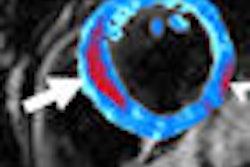VIENNA - Adjunctive use of ultrasound in dense breasts can lead to a significant increase in breast cancer detection, according to a large-scale trial reported Sunday at the European Congress of Radiology (ECR). But another presentation found that MRI mammography did even better.
In the first study, researchers from the University of Kiel in Germany evaluated ultrasound's performance in patients with dense breasts (BI-RADS density categories 3 or 4) as part of the QuaMaDi project, a quality management initiative in the German state of Schleswig-Holstein. The QuaMaDi study cohort included 59,514 patients (mean age, 54.9 years) and 102,744 mammograms conducted between 2001 and 2005.
In the QuaMaDi patients, breast ultrasound was indicated in all women graded as BI-RADS 3 or 4, for those who had a suspicious clinical examination, and in cases of masses found on mammography. The researchers defined abnormalities as positive if biopsy findings revealed malignancy and as negative if biopsy findings or all examinations turned out to be benign.
Overall, ultrasound detected 116 mammographically occult cancers out of 62,006 cases, or approximately 1.9/1,000 exams, according to presenter Dr. Fritz Schaefer. The combination of mammography and ultrasound found 1,019 cancers, a 12.8% improvement over the 903 cancers found by mammography alone.
"And in groups [BI-RADS 3 and 4], we found supplementary [15.9%] more cancers by additional ultrasound than by mammography alone," he said.
Breast MR
In a second study examining imaging of the dense breast, researchers from the University of Rome "La Sapienza" found that breast MRI outperformed a combination of mammography and ultrasound.
"Diagnostic information available [on MRI] is significantly superior to that attainable with x-ray mammography and ultrasound," said presenter Dr. Sabrina Cagioli.
The researchers retrospectively studied a total of 238 women with dense breast parenchyma (BI-RADS 3 or 4) who were considered to be suspicious for breast cancer or who had inclusive findings based on clinical exam, ultrasound, or mammography.
Of these 238 patients, 43 had MRI and mammography, 98 (who were younger than 40) had MRI and ultrasound, and 97 received all three examinations. Breast MRI was performed using a 1.5-tesla scanner and 0.1 mmol/kg of gadobenate dimeglumine.
Separate and combined assessments of unenhanced, enhanced, and fat-subtracted images were performed by two readers, who evaluated lesion morphology, lesion conspicuity, enhancement patterns, and time-signal intensity curves of the detected lesions.
The breast MRI exams were interpreted in conjunction with the patient's clinical history and compared with findings from mammography and whole-breast ultrasound, Cagioli said.
Lesions considered malignant on breast MRI (BI-RADS categories 4 or 5) received histological evaluation, while patients with BI-RADS 3-graded lesions had a follow-up MRI in six months. Lesions graded as BI-RADS 1 or 2 were followed-up at six months with the same technique that detected the suspicious lesions, she said.
Of the 238 women included in the study, 121 (50.8%) had at least one confirmed malignant lesion, whereas 117 had benign or no lesions, she said.
In patients who received all three imaging modalities, MRI detected 135 lesions, compared with 85 for mammography and 107 for ultrasound. MRI yielded diagnostic accuracy of 95.4%, compared with 57.2% for mammography and 72.3% for ultrasound. The difference was statistically significant (p < 0.015).
In addition, breast MRI detected all 55 lesions of the women who received all three imaging modalities and had confirmed malignant lesions at final diagnoses, Cagioli said. Mammography turned in 40/55 (72.7%) true-positive findings, while ultrasound had 47/55 (85.5%) true-positive results.
The researchers also noted that breast MRI detected more cases of multifocal, multicentric, and synchronous contralateral disease. MRI had one false negative (a case of intralobular carcinoma) and two false positives.
In 28 of the 121 cases with malignant lesions, MRI positively affected patient management decisions, she said. A negative impact was seen only in two patients.
"This retrospective analysis confirmed that a single 0.1 mmol/kg dose of gadobenate dimeglumine is effective for breast MRI in women with dense breast parenchyma," Cagioli concluded. "If larger studies confirm our results, MRI should be performed in all cases in women with dense breast parenchyma, and this technique might prove useful as an adjunct screening modality in these women."
By Erik L. Ridley
AuntMinnie.com staff writer
March 8, 2009
Related Reading
Triple reading boosts breast cancer detection rate, March 7, 2009
Breast MRI CAD algorithm predicts cancer metastasis, February 6, 2009
AJR studies show decline in mammo use, workforce shortages, February 3, 2009
FDG-PET/CT improves detection of breast cancer, February 2, 2009
New breast imaging applications show diagnostic promise, January 20, 2009
Copyright © 2009 AuntMinnie.com



















